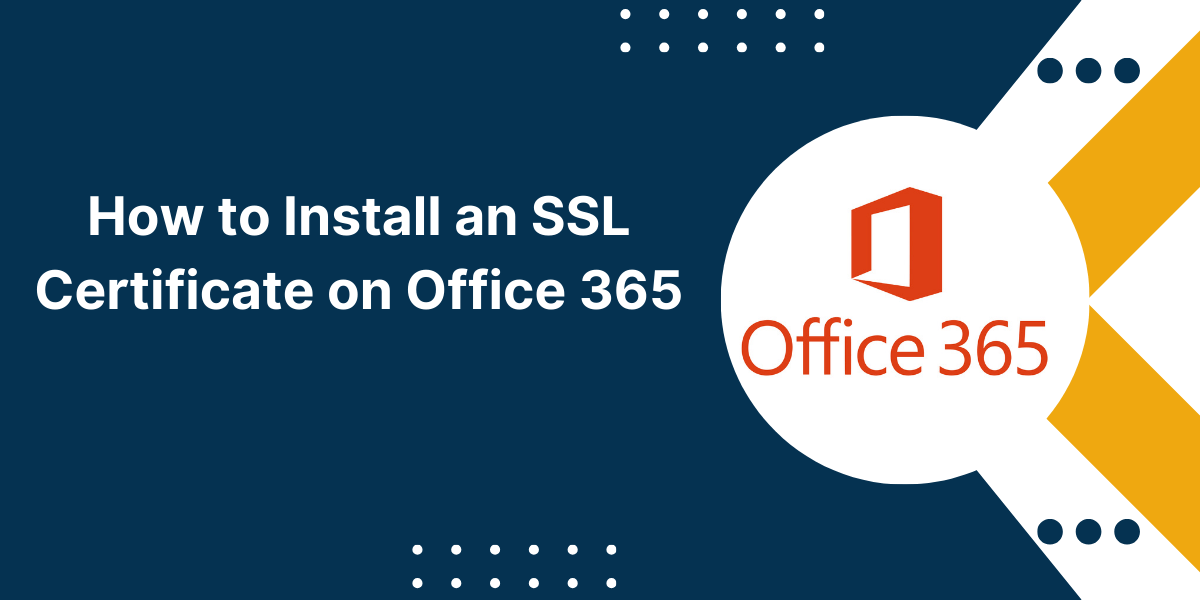CSR Creation & SSL Certificate Installation on Microsoft Azure
SSL certificates are essential for securing communications between a web server and web browsers. They allow data to be transmitted in an encrypted format, protecting sensitive information like login credentials and personal data. Microsoft Azure offers a simple way to install SSL certificates for your websites and web applications hosted on Azure virtual machines or cloud services. This ensures that visitors connect to your site over HTTPS instead of insecure HTTP. In this comprehensive guide, we will walk you through the entire process on how to install SSL certificate on Microsoft Azure step-by-step.
Prerequisites Before Installing SSL Certificate on Microsoft Azure
Before you can install an SSL certificate on Azure, you need:
- An Azure subscription and access to the Azure portal.
- Ownership of a custom domain name (like www.yourdomain.com).
- An SSL certificate file in .PFX or .CRT format from a trusted Certificate Authority like DigiCert or GoDaddy.
- Access the server or application where you want to install the SSL certificate.
The SSL certificate file should include the private key, public key certificate, intermediate certificates, and root certificates. Having all components in one PFX file makes the installation process simpler.
Step-by-Step Guide to Install SSL Certificate on Microsoft Azure
Follow these steps to install SSL certificate on Microsoft Azure and get https quickly.
Step 1 – Add Custom Domain to Azure App Service
If you are using Azure App Service for your web app or API app, the first step is mapping your custom domain name to the app.
Log in to the Azure portal and navigate to the App Service resource. Under Settings, select Custom domains. Click on Add custom domain and enter your fully qualified domain name (www.yourdomain.com). Azure will provide a verification ID – create a CNAME record with your DNS provider to map the domain to the Azure-provided domain name.
Once domain verification completes, your custom domain will show as verified under Custom domains.
Step 2 – Add SSL Certificate to Azure Web App
For Azure Web Apps, SSL certificates can be directly added through the Azure portal.
Navigate to the Web App resource in the portal and click on TLS/SSL settings under Settings. Click on Private Key Certificates and select Upload Certificate.
You will need:
- Certificate – The .PFX or .CRT file
- Certificate Password – If your certificate file is password protected
- Host Name – The hostname for your domain (e.g. www.yourdomain.com)
Upload your certificate file and password. Azure will install the SSL certificate and bind it to the hostname.
Step 3 – Add SSL Certificate to Azure Cloud Service
For Azure Cloud Services, you need to install the SSL certificate on the virtual machine running your web role.
You can upload the certificate directly through the portal or manually install it by RDPing into the server.
Option 1 – Portal Upload
Navigate to the Cloud Service resource in Azure and go to Certificates under Settings. Select Upload and upload your .PFX certificate file along with the password.
Azure will install the certificate under Certificates – Current in the Computer certificate store.
Option 2 – Manual Installation
First, RDP into the virtual machine running your web role. Open the certificate snap-in for the local computer by going to run and type in certmgr.msc.
Right click on Personal and select All Tasks > Import. In the certificate import wizard choose the following options:
- File to import – Your SSL certificate .PFX file
- Password – The password for your certificate
- Certificate store – Place all certificates in the following store
- Select the Personal store
Click finish to install the certificate. Your SSL certificate will now show up under the Personal certificates.
Step 4 – Bind SSL Certificate to Website in IIS
Once the SSL certificate is installed on the server, you need to bind it to the website in IIS that needs to be secured.
Open IIS and navigate to the website you want to configure SSL for.
- Click on Bindings in the Actions pane.
- Click on Add.
- In the Type dropdown, select https.
- Set the SSL certificate to your imported certificate.
- Select the correct hostname in Hostname.
- Click OK.
This will bind the SSL certificate to the website in IIS.
Step 5 – Enable HTTPS Protocol and Port in Website
The final step is to enable HTTPS protocol for the website and add a binding for port 443 which is used for HTTPS traffic.
- Double click on the HTTPS protocol in Sites > Your Website > Bindings
- Check the option “Require Server Name Indication”
- Click on the binding for port 80 and change the hostname to “All Unassigned” if needed
- Click Add in the Site Bindings
- Set Type as https, the IP address as “All Unassigned”, Port as 443, and Hostname as your domain
- Click OK
This will ensure HTTPS requests are handled properly by your Azure VM.
Step 6 – Test HTTPS Access
Once all steps are completed, you can test accessing your website over HTTPS to verify the SSL certificate is installed correctly.
Try accessing your domain using https:// prefix instead of http:// and confirm there are no certificate errors. You can also use an SSL testing tool like ssllabs.com to test your domain and inspect the SSL certificate.
And that’s it! Your Azure website or web application should now be accessible and secure with HTTPS enabled.
Renewing Azure SSL Certificates
SSL certificates have an expiration date set by the issuing Certificate Authority. Once expired, you will need to renew your certificate and reinstall it on Azure.
Most CAs will send you a notification email before expiration to purchase a renewal certificate. Typically, renewing an SSL certificate is quicker than the initial issuance process.
Follow these steps to renew an expiring Azure SSL certificate:
- Obtain your renewed SSL certificate from your CA (they may allow auto-renewal).
- Upload and install the renewed certificate through the Azure portal following the same steps.
- Overwrite the previous expired certificate with the new one.
- Restart your web apps/cloud services for the new certificate to take effect.
- Verify you can access your site without any certificate warnings.
Be sure to renew your certificates before the expiration date to avoid any downtime or certificate warnings for your users.
Some CAs like DigiCert allow auto-certificate renewal which automatically renews the certificate on Azure before expiration. This avoids any manual steps or downtime when your certificate is renewed.
Troubleshooting Common Azure SSL Issues
Here are some common issues and fixes when installing or renewing SSL certificates on Azure:
SSL Certificate Expired
If you see browser warnings about an expired certificate, follow the renewal steps to install an updated certificate from your CA. Restart web apps/cloud services for the new certificate to take effect.
SSL Certificate Not Yet Valid
This means the certificate is not activated yet. Wait for some time until the CA validates and activates the certificate. Then reupload the certificate on Azure.
Certificate Domain Mismatch
This error occurs if the domain name on the SSL certificate does not match your web app domain. For example, the cert is issued for www.domain1.com but your site is on www.domain2.com. Request and install a certificate with the correct domain name.
HTTPS Site Loading Issues
If your site has issues loading HTTPS pages, make sure you have enabled the HTTPS protocol in IIS, added proper port bindings, and there are no errors associated with the certificate.
SSL Certificate Chain Issues
If the intermediate and root certificates are missing, you may face SSL trust issues. Make sure your certificate file includes all certificate chain components required by the CA.
Invalid Certificate Password
Double check the password you entered is correct if Azure shows an invalid password error during certificate upload. If you lose the password, work with the CA to recover or reissue the certificate.
Can’t Remove Previous Certificate
You may need to unlink the previous certificate from the web app under TLS/SSL settings before uploading a renewed certificate if facing issues.
Following the steps in this guide and properly troubleshooting errors should help you install and renew SSL certificates seamlessly on Azure.
Conclusion on Install SSL Certificate on Microsoft Azure
Installing SSL certificates on Azure is critical for securing your websites and applications. This guide covered the end-to-end process of uploading SSL certificates to Azure services like Web Apps, Cloud Services, and Virtual Machines. We discussed how to obtain SSL certificates, install them through the Azure portal or manually, bind to websites in IIS, enable HTTPS protocol, and test secure access. With SSL configured, your apps will serve encrypted traffic over HTTPS. Be sure to renew certificates before expiration to avoid downtime. Following proper SSL certificate management practices will keep your Azure hosted apps trusted and secure for customers.
FAQs about Install SSL Certificate on Microsoft Azure
What type of SSL certificates can be installed on Azure?
Azure supports common SSL certificate types like single domain, wildcard, multi-domain (SAN), and extended validation certificates. Both public and private CA issued certificates can be installed.
Can I install free SSL certificates on Azure?
Yes, you can install free SSL certificates like Let’s Encrypt on Azure. The process of uploading and configuring these certificates is the same as paid certificates. Free certificates have a shorter 90-day validity period so require more frequent renewals.
What Azure services support installing SSL certificates?
The primary services that allow SSL certificate installation include:
- Azure App Service for web apps and API apps
- Azure Cloud Services for web roles and worker roles
- Azure Virtual Machines running IIS
Do Azure CDNs support SSL?
Yes, Azure Content Delivery Network (CDN) profiles can be configured to support HTTPS connections. You need to upload your SSL certificate to the CDN endpoint for it to serve content over HTTPS.
Can I automate SSL certificate management on Azure?
Yes, you can automate SSL certificate provisioning, deployment, and renewal on Azure using tools like PowerShell scripts, Azure Resource Manager templates, and integrations with CAs that support auto-renewal. This helps simplify certificate management.
What happens if my SSL certificate expires on Azure?
If an SSL certificate expires on Azure, users will start seeing certificate warnings when trying to access your site over HTTPS. You need to renew and reinstall the SSL certificate before expiration to avoid any certificate errors.
Is Wildcard SSL supported on Azure web apps?
Yes, Azure Web Apps allow installing wildcard SSL certificates (e.g. *.yourdomain.com) which secures the root domain as well as all subdomains in a single certificate.



